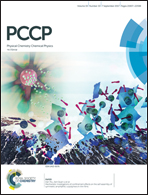Impact of sequential surface-modification of graphene oxide on ice nucleation†
Abstract
Base-washed graphene-oxide which has been sequentially-modified by thiol–epoxy chemistry, results in materials with ice-nucleation activity. The role of hydro-philic/phobic grafts and polymers was evaluated with the most potent functioning at just 0.25 wt%. These 2-D hybrid materials may find use in cryopreservation and fundamental studies on ice formation.



 Please wait while we load your content...
Please wait while we load your content...